|
Fujitsu LifeBook UH900 Mini-Notebook
Fujitsu shrunk the notebook, but not its capabilities: Windows 7, multi-touch, GPS, full keyboard, all in a tiny package.
by Conrad H. Blickenstorfer
In this review we're looking at the Fujitsu UH900 Mini-Notebook. It is a totally unique, and quite compelling, machine that will be the perfect solution for some while others won't be able to figure out why it even exists. Exist it does, though, and that means Fujitsu has a market for it. Let's see what that market is.
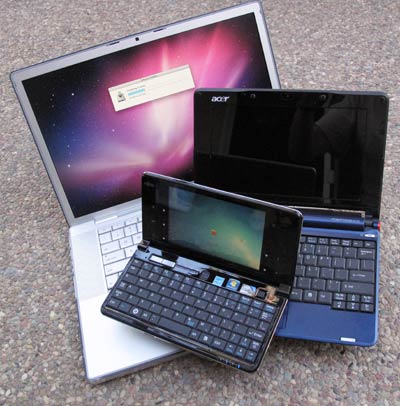 The picture to the left pretty much illustrates what the UH900 is, and how it fits in. The picture to the left pretty much illustrates what the UH900 is, and how it fits in.
It's tiny.
The image shows a 15-inch Apple MacBook Pro, itself a sleek and compact notebook; a super-compact Acer Aspire One with an 8.9-inch display; and then the Fujitsu UH900, which is a couple of size smaller than even a small netbook, and just a fraction the size of a compact notebook. Measuring 8 x 4 inches and being less than an inch thick, in terms of size the UH900 is reminiscent more of one of those handy (albeit not very successful) Windows CE clamshells from the late 90s than even of the smallest modern netbook. In fact, the spiritual successors of the UH900 were the little Fujitsu Poqet PC and HP Palmtop clamshells of the early 1990s that ran MS-DOS and theoretically could do everything a "real" PC could do.
The UH900, likewise, can do almost everything a full-size notebook can do. It runs Windows 7 Home Premium, it has multi-touch, and though its display measures just 5.6 inches diagonally, its 1280 x 800 pixel resolution is higher than that of all those tens of millions of netbooks (which usually have 1024 x 600 pixel) and, in fact, as high as what the Lifebook T4410 offers on its much larger 12.1-inch display (see our review of the Fujitsu Lifebook T4410).
One problem, right off the bat, is that the UH900 is not inexpensive. The prices of notebook computers have come down so much over the past few years that a starting list price of US$999 is hundreds more than that of many full-size notebooks with 15 or 17-inch displays and tons of power and features. It's also far more than the US$350 or so that is the primary reason why netbooks are so successful. Pricing, of course, is hard to figure out. The telcos want us to believe that a dinky little smartphone would cost $700 or so without their subsidies. If that is true and miniaturization comes at a price, then the UH900 is almost a bargain, especially considering that it usually can be had for about US$850 after rebates.
What you get in a Mini-Notebook?
Thanks to Fujitsu's ever-helpful Wendy Grubow who made a review machine available, we got a chance to spend several weeks with this littlest LifeBook, and found it a fascinating device that will indeed have great appeal to some, and none to others. A conversation with Paul Moore, who is Senior Director of Mobile Product Development, answered some of the obvious questions. The UH900, for example, was not designed as some sort of premium netbook. Instead, Fujitsu targeted mobile professionals who want full Windows 7 functionality in a device that fits into a suit pocket. And, of course, also to gadget lovers who are always on the lookout for the coolest and most outrageous technology they can find.
The UH900, however, is far from just a technology demonstration. It's a fully functional computers that packs a lot of power into a very small package. And that, of course, means compromises.
While the 5.6-inch display is much larger than anything you can get on a smartphone, it's awfully small when you run Windows 7 on it. The very high 1280 x 800 pixel resolution means that everything is stunningly crisp and sharp. In fact, the UH900's 270dpi resolution is way ahead of most handhelds, and not far behind Apple's vaunted iPhine 4 "retina" display with its 326dpi. Problem is that, paired with Windows 7 that was never designed for a display this small, icons and text are tiny and often hard to read.
On the processor side, Fujitsu chose an Atom CPU, but not one of the N-Series Atoms that power all those millions of netbooks. Instead, the UH900 runs on a 1.6GHz Atom Z530, a chip more often seen in vertical market devices and tablets. The difference between N-Series and Z-Series Atom chips doesn't seem to be entirely clear to anyone, but it's safe to say that the Z-Series handles high definition video better. We downloaded full 1080p movie trailers, and they run smoothly and without hiccups, something that most netbooks cannot do. Now full 1080p means 1920 x 1080 resolution and in order to really enjoy it you'd need a Bluray drive, neither of which the UH900 has, but it's still a definite plus to be able to run smooth HD video.
That said, the Z530 is still an Atom chip, a processor designed for small size, low cost, and low power consumption. Flat-out performance isn't any Atom's forte, and while the UH900 is quick enough, there are often situations where you'd want some extra punch. All that wonderful multi-touch functionality of Windows 7, for example, takes quite a bit of processing power, and so the 2.0GHz Z550 that's optionally available in Japanese versions of the UH900 would definitely come in handy. The cost for the premium chip is just too high for the US market, says Moore. They had to try very hard as is to come in under US$900.
What do you get with Fujitsu nini-notebook is a roughly VHS-cassette-sized (remember those?) miniature version of a full notebook. Where most such designs make concessions to their size in their display resolution, features or keyboard layout, Fujitsu makes almost none. While the screen is small, it has the same resolution as much larger notebooks, the QWERTY part of the standard-looking keyboard is a respectable 74%-scale, and there are standard USB ports. There isn't room for an internal optical drive, of course, and the standard touchpad has been replaced with a tiny rectangular rubber pad and two mouse function buttons above the keyboard.
As you can see in the composite image below, the Lifebook UH900 is a tidy little clamshell.
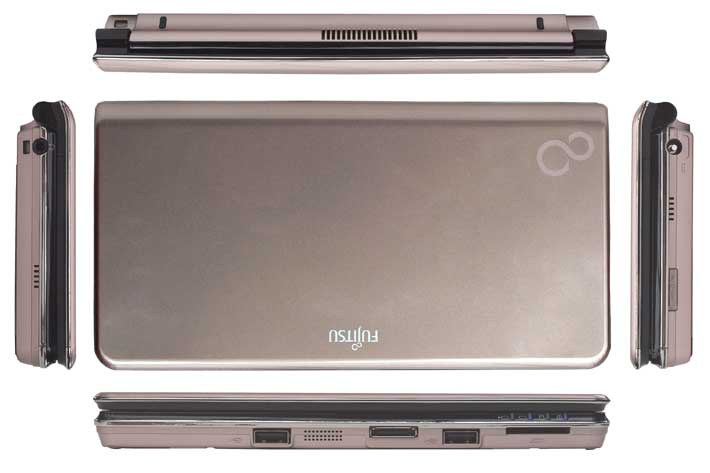
On the left side are:
- a headphone jack
- a strap/pen tether attachment point
- air vents (yes, this is an Atom-powered device with a fan)
On the right side you find:
- the power jack
- a switch to turn Bluetooth and WiFi on and off
- more air vents
On the front side are:
- two full USB 2.0 ports (but both facing forward where they can get in the way)
- a speaker
- an external monitor/LAN adapter connector (adapter cable included)
- a SD Card reader
Below the display are:
- left and right buttons
- a status light indicator panel
- the power/suspend/resume button
- the cursor control pad
To the left and right of the display are:
- three application buttons on the left
- two application buttons on the right
- a web camera
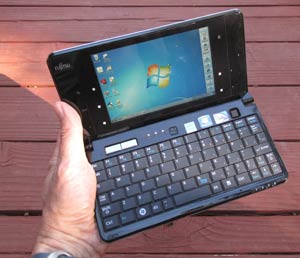 The 74%-scale 75-key keyboard has black keys with clear white writing for primary symbols and smaller blue and orange markings for the two dozen or so function key operations (including a numeric keypad). The keyboard, which can perform all the functions of a standard 101-key keyboard, is well organized and provides good tactile feedback. It is, of course, much smaller than a standard keyboard, but still nowhere near as small as those on some UMPCs. The 74%-scale 75-key keyboard has black keys with clear white writing for primary symbols and smaller blue and orange markings for the two dozen or so function key operations (including a numeric keypad). The keyboard, which can perform all the functions of a standard 101-key keyboard, is well organized and provides good tactile feedback. It is, of course, much smaller than a standard keyboard, but still nowhere near as small as those on some UMPCs.
For cursor control and navigation, the Lifebook UH900 has the afore-mentioned touchpad with mouse buttons above the keyboard in addition to touch. There are also five touch buttons next to the display. By default, they provide:
- Screen magnification (toggles through small, medium and large)
- ECO (toggles between normal and power savings modes)
- A button (by default brings up the Touch Launcher)
- Scroll up and down
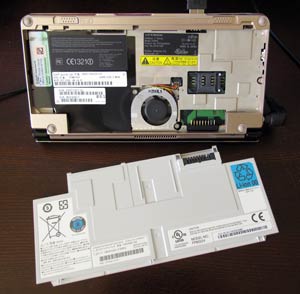 On the bottom right a battery of status lights (Charge status, battery level, flash drive access, and power). The status panel above the keyboard shows the locking functions (numbers, caps, screen). On the bottom right a battery of status lights (Charge status, battery level, flash drive access, and power). The status panel above the keyboard shows the locking functions (numbers, caps, screen).
The bottom of the UH9000 is almost entirely taken up by a cover that incorporates the computer's Lithium-Polymer battery. It provides 7.2 V/1,800mAH for a total of 13 watt-hours (and here we'd have liked to see a bit more punch, even at the cost of a slightly thicker device).
Removing the battery lets you peek inside the UH900 with its finely crafted magnesium chassis, the somewhat exposed fan, and the SIM slot.
Performance and battery life
The design challenge with notebook computers, and with tiny ones like the UH900 in particular, is to find a compromise between performance and acceptable battery life. Faster processors need more power, which means a larger battery, which means more weight. In truly tiny machines space plays a matter as there won't be enough space for extensive thermal cooling or a big fan. To solve this problem, Fujitsu chose an Intel Atom processor, but not the ubiquitous N270 (or its N450 successor) doing duty in tens of millions of netbooks; instead, the UH900 comes with a 1.6GHz Atom Z530, a chip used in many industrial and vertical market devices. Thermal design power (defined as the maximum amount of power a computer's cooling system needs to dissipate, and used by Intel as a measure of power efficiency) is an extremely low 2.3 watts, only a small fraction of what standard mobile processors use.
We benchmarked the Lifebook UH900's performance with Passmark Software's PerformanceTest 6.1 that runs about 30 tests covering CPU, 2D graphics, 3D graphics, memory, and disk and then computes scores for each category and an overall PassMark score. For comparison we added the results of another tiny clamshell, the General Dynamics Itronix MR1 and those of a standard netbook, the Acer Aspire One. The benchmark results are as follows:
|
PERFORMANCE
|
Fujitsu UH900
|
GD-Itronix MR1
|
Acer Aspire 1
|
|
Processor
|
1.6GHz Atom Z530
|
1.2GHz Core Solo U1400
|
1.6GHz Atom N270
|
|
Thermal Design Power
|
2.3 watts
|
5.5 watts
|
2.5 watts
|
|
CPU Mark
|
209.5
|
238.1
|
239.1
|
|
2D Graphics Mark
|
51.4
|
180.6
|
144.4
|
|
Memory Mark
|
181.5
|
231.7
|
215.1
|
|
Disk Mark
|
462.1
|
183.2
|
375.8
|
|
3D Graphics Mark
|
31.3
|
88.2
|
81.7
|
|
Overall PassMark
|
192.6
|
202.8
|
208.4
|
|
BatteryMon Power Draw
|
4.4 watts
|
8.6 watts
|
7.3 watts
|
The results are pretty much as expected. The Lifebook UH900 provides netbook-class performance, though the Atom Z-Series has different strengths than the Atom N-Series. The UH900's benchmark numbers in no way reveal the little unit's excellent HD video playback capabilities, but adequately reflect the speedy performance of its standard solid state disk. Interestingly, the performance is also on par with that of the Sore Solo-based Itronix machine. The Core Solo is a much more complex processor and would probably score much higher with a SSD.
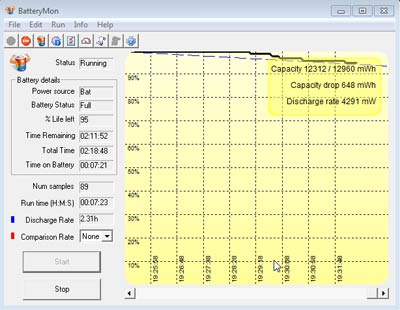 Netbooks are generally known for very good battery life, so how does the UH900 compare? Here, there's both good news and bad news. On the plus side, with just 4.4 watts the UH900 had one of the lowest battery draws we've ever recorded. On the minus side, even this minuscule draw will theoretically deplete the small battery in less than three hours. Netbooks are generally known for very good battery life, so how does the UH900 compare? Here, there's both good news and bad news. On the plus side, with just 4.4 watts the UH900 had one of the lowest battery draws we've ever recorded. On the minus side, even this minuscule draw will theoretically deplete the small battery in less than three hours.
Given that one of the main attractions of super-mobile little computers is that you can take them anywhere, you'd also want to be as independent from power supplies and recharging as possible, and this is where the UH900 can let you down. The low draw of the Atom chip combined with the excellent power management of Windows 7 will ease the pain, and under certain conditions the battery can last a good, long time. Fortunately, Fujitsu offers an optional 27.3 watt-hours 4-cell high-capacity battery. Costing US$139, we'd consider it a must-have with the UH900.
Display
Fujitsu does not make any ruggedness claims or targets for the Lifebook UH900 (despite the high build quality and metal chassis, it actually feels a bit creaky), and there aren't any special options for outdoor use, such as an outdoor-viewable display. As is, the standard display is bright and viewable enough for outdoor use. The picture below shows the downside of the fashionably glossy display—significant reflection in sunlight. Fortunately it's easy to position the little notebook so that the reflections go away, but of anti-glare treatment would certainly be welcome.
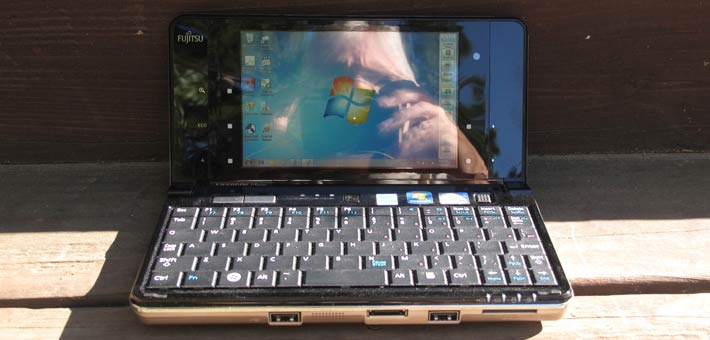
Multi-touch digitizer
Though it does not appear to be absolutely necessary in a device like this, the Lifebook UH900 does have a touch screen. And since as of late, there's been much demand for multi-touch systems capable of doing some of the fancy footwork the Apple iPhone is famous for, that's what the UH900 has, multi-touch.
What does that mean? Well, it's not projected multi-touch as on the iPhone/iPad, so you can either use a stylus or your finger(s). And while some multi-touch implementations recognize just two points (which often makes sense), the UH900 has no such limitations. The included Microsoft Surface Collage, a demo that shows off the Windows 7 multi-touch capabilities, works even with three objects selected and manipulated simultaneously. And in Microsoft Paint, we managed to draw eight simultaneous lines before we ran out of fingers to fit onto the small display.
How does it all work? In theory, great. You can drag, rotate and zoom in and out all with the cool two-finger pinch and expand, and the Launcher provides touch tabs to make things happen. In practice, it's really more of a technology demonstration. That's because a) the screen is just too small to lend itself for touch operation of Windows 7, b) the notebook configuration makes it difficult to operate the display with a pen or fingers, c) Windows 7 is just not a touch OS, and d) the little machine just doesn't have enough punch to provide the smooth, effortless stylus and touch operation that would make touch actually useful. So this part of the UH900 feels a bit labored; it's all there, but it's not that useful.
That's too bad as the UH900 does have all the tools and parts for touch and pen operation. You can do handwriting recognition with the by now very good Microsoft input panel. The recognizer works great, and there is a number of cool pen-based apps, such as snipping tool, the math input panel, etc., that are great on a larger, more powerful pen/touch machine such as the Lifebook T4410, but not so much here.
Below are two of the Windows 7 touch demos, Surface Collage and Surface Globe.

Garmin GPS
The Lifebook UH9000 comes with the full version of Garmin Mobile PC to work in conjunction with the UH900's internal GPS receiver. This is a fairly powerful system that provides significant additional value and functionality.
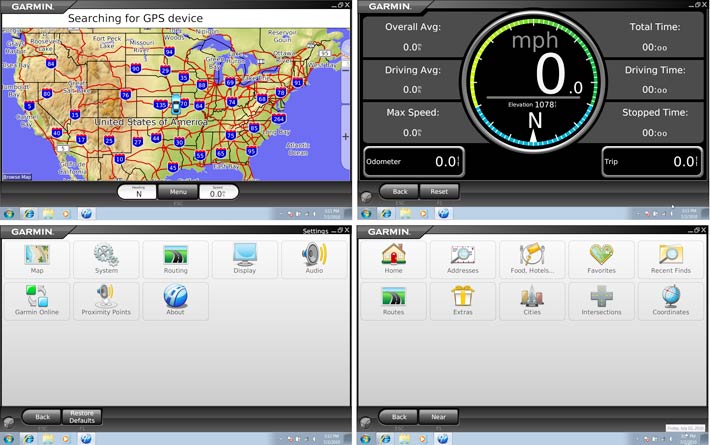
Bottom line
The Fujitsu Lifebook UH900 is a totally unique device that will have devoted fans as well as those who have no use for it. It's an ultra-compact Intel Atom-powered clamshell notebook that's a whole class smaller than even older netbooks with the smaller 8.9-inch displays. Yet, unlike netbooks which are usually austere and rather basic, the UH900 is brimming with features. It has its conceptual origins in the tiny DOS-based clamshells of the late 1980s, but also seems geared toward the Japanese domestic market's fascination with the dazzling variety of miniature electronics one can find in Tokyo's famous electronics district, the Akihabara.
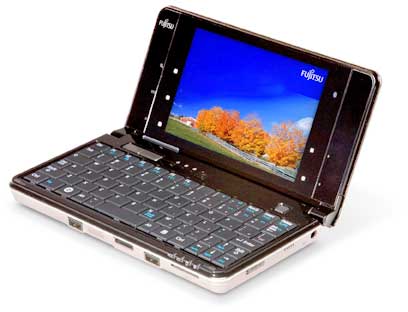 As such, the Lifebook UH900 packs a bit punch into a tiny package. The brilliant 5.6-inch wide-format display sports very high 1280 x 800 pixel resolution. 2GB of RAM comes standard, as does a super-fast 62GB solid state disk. You get multi-touch and very satisfactory onboard connectivity, and it all works quite well thanks to a 1.6GHz Intel Atom Z530 processor, the same that powers many industrial and vertical market panels and tablets. For wireless communications, there's Bluetooth V2.1, 802.11g/g/n WiFi, and even integrated GPS (complete with powerful Garmin Mobile PC mapping software). As such, the Lifebook UH900 packs a bit punch into a tiny package. The brilliant 5.6-inch wide-format display sports very high 1280 x 800 pixel resolution. 2GB of RAM comes standard, as does a super-fast 62GB solid state disk. You get multi-touch and very satisfactory onboard connectivity, and it all works quite well thanks to a 1.6GHz Intel Atom Z530 processor, the same that powers many industrial and vertical market panels and tablets. For wireless communications, there's Bluetooth V2.1, 802.11g/g/n WiFi, and even integrated GPS (complete with powerful Garmin Mobile PC mapping software).
Running Windows 7 Home Premium and supporting an external monitor via the supplied LAN/VGA adapter cable, there's little the UH900 cannot do. That said, the very small size can mean eye-squinting and a learning curve with navigation controls, and the Atom chip isn't quite powerful enough to make multi-touch shine. We'd also recommend the optional extended battery as the standard one seems undersized.
A very nicely equipped UH900 starts at US$849 (as of July 2010). That's a bargain compared to what such boutique electronics used to cost and probably downright cheap in Akihabara terms, but it's still twice as much as a high-end netbook and more than many full-featured notebooks. Price, of course, is relative, and if you need a one-pound Windows 7 micro-notebook with super-high resolution, the UH900 is well worth its price.
-- Conrad H. Blickenstorfer
Fujitsu Lifebook UH900 Specs:
| Type |
Mini-notebook
|
| Processor |
Intel Atom Z530 with 512 KB L2 cache and 533 MHz FSB
|
| CPU speed |
1.60 GHz
|
| Chipset |
Intel System Controller Hub US15W
|
| OS |
Windows 7 Home Premium
|
| Memory |
2 GB DDR2 533 MHz SDRAM in one DIMM slot |
| Display |
5.6" 1280 x 800 pixel WXGA LCD |
| Digitizer |
Projected capacitive multi-touch |
| Keyboard |
75-key keyboard with 16mm key pitch (74%-scale) and 1.2 mm key stroke, touchpad cursor control |
| Storage |
62 GB Solid State Drive
|
| Optical Drive |
none
|
| Expansion slots |
1 SD Card slot and 1 SIM slot
|
| Housing |
Plastic |
| Size |
8.3 x 4.2 x 1.15 inches |
| Weight |
17.8 ounces as tested (with battery)
|
| Operating temperature |
41-95F |
| Humidity |
20-85% relative, non-condensing |
| Operating altitude |
10,000 feet |
| Ingress protection |
unknown |
| Drop |
unknown |
| Vibration |
unknown |
| Power |
2-cell Li-Polymer 7.2 Volt 1,800mAH 13 watt-hour (optional 4-cell 7.2V 3,800mAH high-capacity battery (27.3 watt-hours)) |
| Interface |
2 USB 2.0, audio in/out, adapter cable connector, .78mp megapixel WebCam |
| Wireless |
Atheros XSPAN 802.11b/g/n, Bluetooth v2.1, GPS
|
| Price |
From US$849 (as of July 2010
|
| Contact |
store.shopfujitsu.com.com |
(copyright 2010 RuggedPCReview.com)
|



